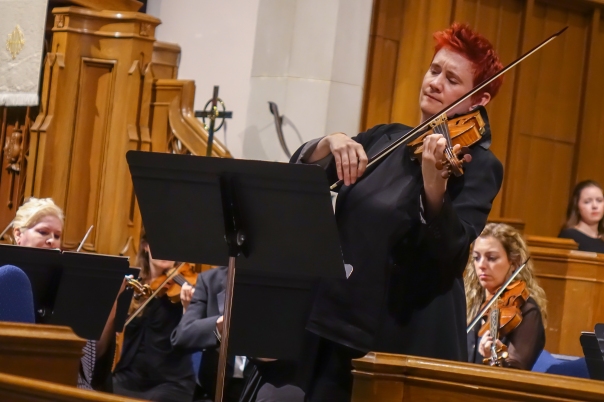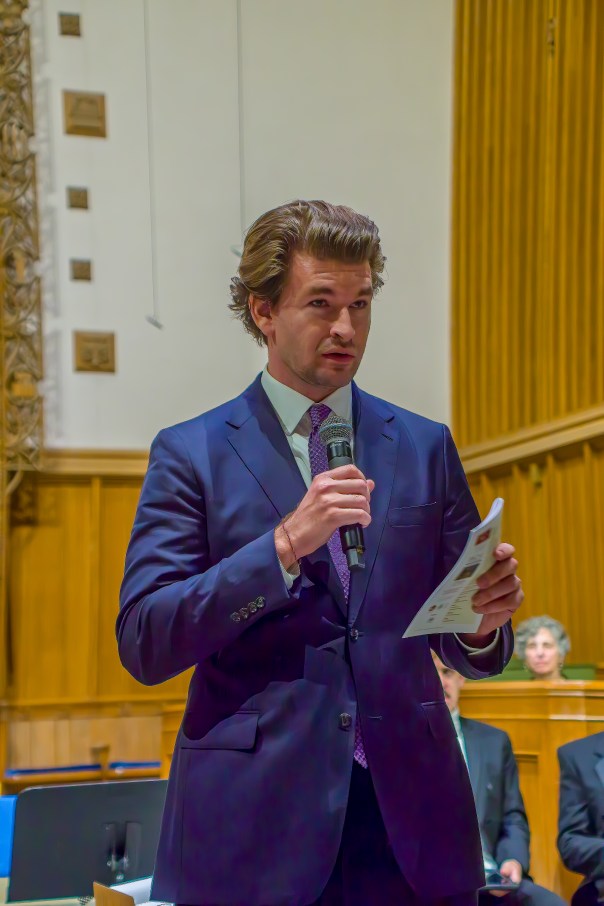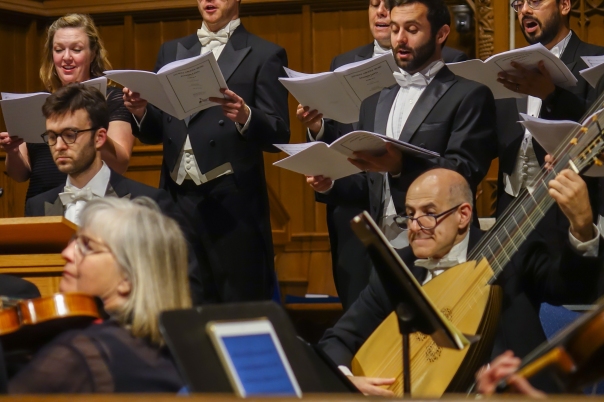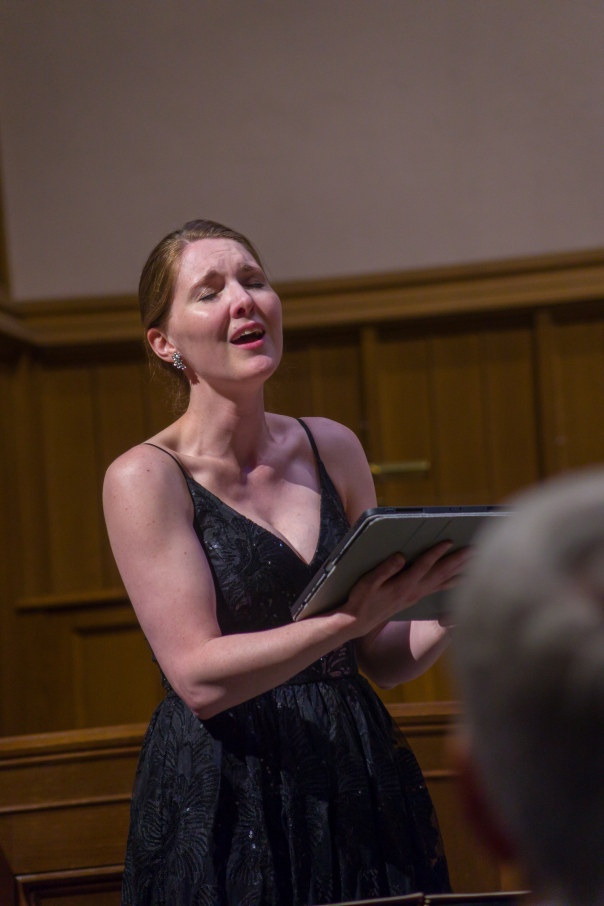
CHARLOTTE, NC – With the departure of the two people most instrumental in establishing Bach Akademie Charlotte and the Charlotte Bach Festival, artistic director Scott Allen Jarrett and chief exec Mike Trammell, we couldn’t help wondering how radical changes might be at the 2024 festival. The new artistic leaders filling in for Jarrett have actually been with the Bach Festival since the first Charlotte celebration in 2018. All three – concertmaster Aisslinn Nosky, cellist Guy Fishman, and keyboardist Nicolas Haigh – have made significant contributions in performance season after season. The new executive director, Garrett Murphy, began his hosting chores last spring at the Venetian Vespers concert, prior to the last year’s Bach Fest that featured marathon offerings of Johann Sebastian’s Christmas Oratorio.
The changes for 2024 were somewhat telegraphed by the first glimpses we had of Claudio Monteverdi’s Vespers of 1610 in that spring concert last year. For the first time, the headline works for the opening and closing concerts at Charlotte Bach are not by Bach. The laurel for the big opening at Sandra Levine Theatre was Antonio Vivaldi’s The Four Seasons, with Nosky fronting a string reduction of the iconic score that reprised her triumph as guest soloist with the Charlotte Symphony a few months before the inaugural festival. Stamping and mugging, red-headed Nosky brought the Red Priest’s electricity back. But with two afternoon sessions devoted to demonstration concerts of the Vespers, the closing concert with Monteverdi’s gem has been clearly designated as this year’s top highlight.
Not that Johann has been totally neglected. He had some play when Peter Blanchette, inventor of the 11-string archguitar, unofficially opened the festival with a “Bach at the Brauhaus” event at the temporary Pianodrome constructed at the Brooklyn Collective. And in the wake of The Four Seasons, where Bach’s “Tilge, Höchster, meine Sünden” served as a handsome preamble, Jonathan William Moyer‘s Organ Recital was all-Bach, an earth-shaking German Organ Mass that may be the best organ concert in the festival’s history.
In this year of transition, the “Bach, the Next Chapter” concert instantly stood out for me as the most telling event in this year’s lineup. Not only was the festival looking at Bach’s predecessors and contemporaries to explore their influence, it was now guiding us forward to examine his legacy – beginning in his own family with his most illustrious son, Carl Philipp Emanuel Bach. That extra stretch of the envelope – at a new venue, the Kathryn Greenhoot Recital Hall, never before called into service at Charlotte Bach – made “Next Chapter” a little more fetching than the half dozen other festival events scheduled at sites making their CBF debuts.
“Next Chapter” began with Johann Sebastian’s Magnificat, but only a small taste of its Canon Perpetuus – played by Nosky, Fishman, and oboist Kristin Olson – enough to establish the Leipzig master’s achievement as a jumping off point. Then before playing CPE’s Sonata for Oboe in G minor, Olson discussed how the younger Bach was intent on diverging with his illustrious father. Without the modern oboe’s metal keys, the baroque oboe would prove to be a fussier instrument, requiring more frequent swabbing, and its tone was noticeably thinner in the opening Adagio movement, with a litheness that seemed even better suited to the middle Allegro. The wide leaps of the closing Vivace were effortlessly navigated, and Olson’s tone grew slightly richer.

Johann Gottleib Graun’s Trio Sonata in B-flat for Violin and Viola actually brought four musicians to the fore. Harpsichordist Jennifer Streeter teamed with Fishman on the continuo while violist Maureen Murchie shared the title roles with Nosky. Introducing the piece, Nosky emphasized the new tendency of composers to give the spotlight to multiple soloists. Yet the promised parity between violin was only confirmed in the opening Adagio before it was discarded in the middle Allegretto, where Nosky was clearly the superior among equals in drawing technical challenges. Murchie had more of a chance to shine in the closing Vivace, where she had the first run at the theme.
All five hands came on deck for Johann Adolph Hasse’s Sonata for Oboe, Violin and Viola, though we were cautioned that Hasse was likely not the true composer of this charming piece. Olson drew most of the spotlight, with Nosky her chief responder, but Murchie had more challenges here than in the preceding piece. Nosky and Murchie withdrew for the next work by Princess Anna Amalia of Prussia, and Olson had the joy of announcing the discovery of a woman composer in the generation that followed Bach. Nosky’s excellent program notes offered only a slight clarification, reminding us that Anna Amalia studied with a student of Johann’s, distancing her musically from Bach by an additional generation.
Olson also confided that the piece was originally written for flute before possessing it in scintillating fashion with her oboe. The beauties of the opening Adagio drew even richer sounds from the oboist, yet Olson had to pause before the ensuing Allegretto “so all the notes will come out,” explaining the troubled relationship between her instrument and moisture as she swabbed. Fishman sat by patiently before upstaging his colleague, helpfully quipping that it was the same with his cello. Not to worry, Olson more than answered back with dazzling work on both the Allegretto and the concluding Allegro ma non troppo.

Nosky and Murchie returned for the evening’s finale, Johann Gottlieb Janitsch’s Quadro in G for Oboe, Violin and Viola, but once again Olson more than justified her top billing – in a four-movement crowdpleaser that was the most radical break with the Baroque Era that we heard. Once again, we had a swabbing pause between movements as Olson primed her instrument for the final fireworks of the Vivace non troppo. If you think of the baroque music canon as a cavalcade of perpetual motion machines, this last salvo was a shocker. Olson excelled yet again, laying down the gauntlet on multiple occasions and, rather than merely repeating, Nosky and Murchie fired back their flaming responses – after dramatic silences that crackled with tension.
Photos by Perry Tannenbaum



















 Review: Charlotte Bach Festival~Opening Celebration
Review: Charlotte Bach Festival~Opening Celebration